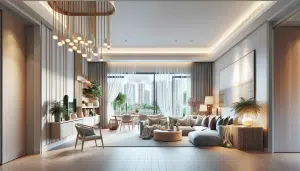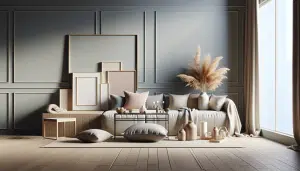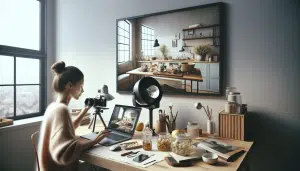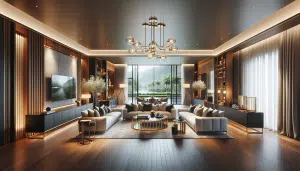The Rise of Minimalist Living and How It Shapes You
Lily Carter October 21, 2025
Minimalist living inspires more people to rethink how much they own and how much they truly need. This engaging guide explores the trend, its benefits, practical steps, and the emotional impact it has for those eager to simplify and add meaning to their lifestyle.
Understanding the Appeal of Minimalist Living
Minimalist living has captivated attention around the world for its focus on simplicity and intentional choices. This trend isn’t just about owning fewer items. It centers around making room for what matters and cutting out physical and mental clutter. The search for minimalist home inspiration and living room designs is growing rapidly online. Many are discovering that by reducing excess, they create space for creativity, connection, and less stress. Digital content, social media, and documentaries have fueled the movement, shedding light on real-world stories of transformation sparked by embracing a minimalist lifestyle.
People often imagine minimalist living as stark, empty rooms. In reality, it can look inviting and stylish. Popular search terms like ‘minimalist bedroom ideas’ and ‘decluttering hacks’ reveal curiosity about integrating minimalism into daily living. This lifestyle can be especially appealing for those seeking more financial freedom, as spending less on possessions can lead to healthier budgets and less anxiety about keeping up with trends. Minimalism brings a sense of control over one’s choices and fosters the freedom to focus energy on people and passions, rather than things.
The global minimalist trend thrives on the idea that less truly can be more. Advocates regularly report feeling lighter, calmer, and more engaged with what remains after decluttering. In online communities, people celebrate milestones like donating clothes or paring down collections. The value of minimalism isn’t in deprivation but in learning to prioritize what enriches life. As more share stories of emotional well-being and mindful consumption, interest in this approach continues to grow.
Decluttering Your Space: Practical Strategies That Work
Tackling clutter is often the first big step toward minimalist living. It’s common to underestimate how much clutter weighs on daily life. Sorting and letting go of unnecessary items can feel daunting, but countless guides suggest starting with small sections—like a single drawer or closet. By categorizing belongings into keep, donate, or recycle, anyone can make steady progress. Professional organizers recommend setting aside short, regular bursts of time instead of marathon sessions. Even fifteen minutes a day can shift both space and mindset.
Practical decluttering techniques often include the ‘one in, one out’ rule. For every new item brought home, something else must go. This approach controls future clutter and keeps priorities clear. Digital declutter is equally vital—deleting old emails and organizing files reduces visual noise in both physical and virtual spaces. Many people also document their journey through minimalist home tours online. These stories offer relatable ideas and community support, motivating others to embrace the challenge and celebrate small wins.
Decluttering’s benefits extend beyond tidier rooms. Many practitioners report sharper focus, improved mood, and greater satisfaction with their living environment. By curating what stays, people develop a deeper appreciation for each item. The act of removing excess can inspire mindfulness in other areas—like how free time or money is spent. Balancing decluttering momentum with patience ensures lasting change and helps prevent a return to old habits. Each decision becomes an opportunity to align lifestyle with personal values.
The Psychological Benefits of Embracing Less
Minimalist living offers remarkable psychological benefits. Reducing clutter is known to support mental clarity and emotional steadiness. Research shows that rooms filled with unneeded items can trigger anxiety, while organized spaces encourage creative and focused thinking (https://www.apa.org/news/press/releases/2010/03/clutter-stress). When individuals practice intentional ownership, they discover that fewer possessions can mean fewer distractions—and fewer decisions to make. This relief from decision fatigue has broad appeal for those juggling busy schedules or life transitions, such as moving or downsizing.
The emotional lift from letting go of unneeded possessions can surprise many. Minimalism is often described as freeing, with advocates sharing stories of feeling “unburdened.” With fewer reminders of incomplete projects or unused items, motivation to focus on passions increases. This can spark a renewed sense of purpose and identity. Minimalist home environments—especially bedrooms and living rooms—are designed to promote calm and restfulness, helping support better sleep and less daily stress.
Adopting a minimalist approach can also support better relationships. When clutter subsides, people may find it easier to connect with others and spend meaningful time together. Families discover that shared spaces become more inviting, encouraging interaction. Many minimalists report fewer arguments about chores or shopping. The simplicity in routine makes space for gratitude, mindfulness, and self-acceptance, which benefits emotional health. Even small steps toward less can bring profound joy, showing that minimalism extends well beyond physical possessions.
Minimalism and Sustainable Living
Minimalist living shares many values with sustainable practices. By buying and using less, households cut down on waste and naturally support environmentally responsible choices. Popular minimalist trends, such as capsule wardrobes and multi-functional furniture, reflect this overlap. Consumers are drawn to products designed to last and made from ethical materials—as evidenced by growing interest in eco-labels. This approach doesn’t just lessen clutter; it lessens environmental impact by reducing landfill and energy usage (https://www.epa.gov/recycle/reducing-waste-what-you-can-do).
Minimalist lifestyles often emphasize mindful shopping. This means making purchase decisions with care and considering the environmental footprint. Many minimalists research before buying, seeking durable goods or secondhand finds. The rise of minimalist living room design is not only about style but about function—choosing pieces that offer lasting value rather than following fleeting trends. Sustainability and minimalism blend together, guiding choices that benefit both household well-being and planetary health.
Waste reduction extends to daily habits too. Minimalists frequently adopt routines like meal planning to avoid food waste, shared transportation to cut emissions, and digital subscriptions to limit paper clutter. These small shifts add up over time, showing that individual choices matter. For many, sustainable minimalism isn’t an all-or-nothing proposition. It’s about making better decisions one step at a time. This approach inspires community efforts, such as neighborhood swaps and donation drives, multiplying the impact of each person’s commitment.
Styling Your Home with a Minimalist Touch
Minimalist home design celebrates light, order, and purpose. Interior designers suggest beginning with core elements: neutral colors, clean lines, and furniture serving multiple needs. Living rooms with plenty of natural light and open floor plans feel welcoming and modern. Removing unnecessary décor creates room for statement pieces—a central sofa, a single piece of art, or textured textiles—that set a calming tone. The most-sought minimalist bedroom ideas include low-profile beds and streamlined storage solutions to keep essentials at hand and distractions out of sight.
Small spaces especially benefit from a minimalist approach. With careful layout, even studios can feel airy and functional. Mirror placement and natural light amplify openness. The key is intentional displays and storage. For example, open shelving highlights carefully chosen items. In the kitchen, using matching containers and keeping counters clear not only looks appealing but also makes daily routines smoother. These ideas show that anyone can transform their home regardless of square footage.
Personal style and minimalism are not mutually exclusive. Many blend favorite colors, inherited pieces, or handmade décor with minimalist aesthetics. This makes every home unique, reflecting the values and stories of its residents. Embracing minimalism in interior design is about choosing what brings joy and function, rather than adhering to rigid rules. It invites experimentation and ongoing adjustment, ensuring the home evolves alongside its inhabitants. Minimal design can be cozy, vibrant, or even eclectic—always focused on what matters most.
Transitioning to a Minimalist Mindset
Adopting a minimalist mindset is about more than just letting go of ‘stuff.’ It requires reflection, openness, and sometimes trial and error. Many start this journey out of necessity—moving, downsizing, or navigating major life changes. Others are drawn by curiosity or the desire for a slower, more meaningful lifestyle. Mindful consumption is at the heart of minimalism, challenging the impulse to acquire more. Practicing gratitude for what’s already present helps anchor the process. Documenting progress or sharing the journey with others can keep motivation high.
Challenges are common along the way. Letting go of sentimental items, overcoming fear of needing something in the future, or facing social pressure to keep up with trends are frequently cited hurdles. Self-compassion and patience are key. Experts suggest starting with easier items and building confidence before tackling more emotional possessions. Learning from minimalist blogs, books, or local groups can provide reassurance and ideas. Minimalism ultimately becomes easier as the benefits—such as peace of mind and added clarity—outweigh initial discomforts.
Minimalist living is not about perfection or deprivation. It is a continual process of reassessing what matters and creating space for life’s evolving needs. Many find that even small steps can bring relief and joy. Discovering new hobbies, connecting more deeply with loved ones, or finding satisfaction in everyday rituals becomes possible when less time and energy is devoted to things. Ultimately, minimalism is flexible—adaptable to different seasons, personalities, and priorities—empowering individuals to shape a life that genuinely feels like their own.
References
1. American Psychological Association. (2010). Press Release: Clutter and Mental Health. Retrieved from https://www.apa.org/news/press/releases/2010/03/clutter-stress
2. U.S. Environmental Protection Agency. (n.d.). Reducing Waste: What You Can Do. Retrieved from https://www.epa.gov/recycle/reducing-waste-what-you-can-do
3. Canadian Centre for Occupational Health and Safety. (2022). Benefits of Decluttering. Retrieved from https://www.ccohs.ca/oshanswers/hsprograms/clutter.html
4. Harvard Health Publishing. (2020). Mindfulness and Minimalism. Retrieved from https://www.health.harvard.edu/mind-and-mood/mindfulness-and-decluttering
5. National Institutes of Health. (2019). Minimalism and Wellbeing. Retrieved from https://www.ncbi.nlm.nih.gov/pmc/articles/PMC6775445/
6. National Association of Productivity and Organizing Professionals. (n.d.). Decluttering for Wellness. Retrieved from https://www.napo.net/page/about







